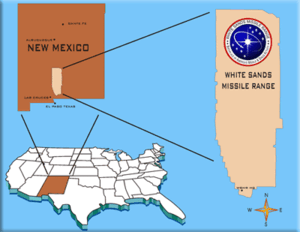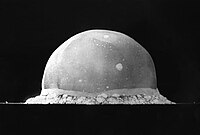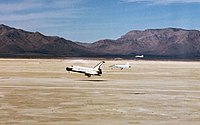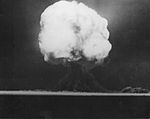White Sands Proving Ground (1945) | |
|---|---|
| Part of United States Army | |
| New Mexico, Southwestern United States | |
 Outline of WSMR at the Tularosa Basin | |
 WSMR location | |
| Coordinates | 32°33′47″N 106°34′12″W / 32.56306°N 106.57°W |
| Site information | |
| Controlled by | Commanding General |
| Open to the public | WSMR Museum |
| Site history | |
| Built | 9 July 1945[2] |
| Built by | Ordnance Corps (United States Army)[2] |
| Garrison information | |
| Current commander | MG Gwen Bingham (2012–) [3] |
| Past commanders |
BG Richard L. McCabe (2007–2008) BG David L. Mann (2008–2009) BG John G. Ferrari (2011–2012) [4] |
| Garrison | White Sands Missile Range Garrison Commander] |
| Occupants |
|
| ||||||||
White Sands Missile Range (WSMR) is a United States Army rocket range of almost 3,200 square miles (8,300 km2) in parts of five counties in southern New Mexico. The largest military installation in the United States, WSMR includes the Oscura Range and the WSMR Otero Mesa bombing range.[6] WSMR and the 600,000-acre (2,400 km2) McGregor Range Complex at Fort Bliss to the south, form a contiguous swath of territory for military testing.[6]
Trinity test site[]
Public land grazing leases were canceled in December 1941 for the newly formed Alamogordo Bombing and Gunnery Range. Robert Goddard transferred his rocket research group from Roswell, New Mexico to Annapolis, Maryland in July 1942. The Trinity (nuclear test) site was selected in November 1944; and the first atomic bomb was detonated at the Trinity test site on 16 July 1945.[7] The Trinity Site was declared a National Historic Landmark district on 21 December 1965,[8][9] and listed on the National Register of Historic Places on 15 October 1966.[10]
V-2 rockets[]
The first of 300 railroad cars of V-2 rocket components began to arrive at Las Cruces, New Mexico in July 1945 for transfer to WSPG.[11]:246 Launch Area 1 Army blockhouse (Launch Complex 33) was completed in September. In November General Electric employees began to identify, sort, and reassemble V-2 rocket components in Building 1538, designated as Assembly Building 1. German rocket scientists of Operation Paperclip arrived at Fort Bliss in January 1946 to assist the V-2 rocket testing program.[7] After a static test firing of a V-2 engine on 15 March 1946, the first V-2 rocket launch from Launch Complex 33 was on 16 April 1946. Approximately two V-2 launches per month were scheduled from Launch Complex 33 until the German rocket scientists transferred from Fort Bliss to Redstone Arsenal in 1949. Remaining V-2 rockets were launched from Launch Complex 33 on a reduced frequency until 1952. Launch Complex 33 was designated a National Historic Landmark on 3 October 1985.[12][13] Refurbished Mittelwerk V-2 rocket #FZ04/20919 was returned to the WSMR Museum in May 2004 after being taken to the Kansas Cosmosphere and Space Center in September 2002 for restoration.
Current operations[]
- At White Sands Test Facility (WSTF), Ground Support for the Tracking and Data Relay Satellite (TDRS) network of communications satellites
- At WSTF, Solar Dynamics Observatory – SDO ground station consists of two dedicated (redundant) 18-meter (59 ft) radio antennas at White Sands.
- Orion Project Launch Abort Flight Test Complex
- Missile testing and range recovery operations[14]
Chronology[]
- 1941 – 13 April: Alamogordo Army Airfield established.[7]
- 1944 – February: Major General Gladeon M Barnes, chief of the Technical Division of the Office of Chief of Ordnance in Washington, sent teams of the War Department and the Ordnance Department of the Corps of Engineers to look for a US site for missile research.[15]:389
- 1945 – 20 February: The Secretary of War approved the establishment of White Sands Proving Ground.[11]:246[15]:290
- 1945 – Spring: Private F test firing[16]
- 1945 – 25 June: Drilling of water wells began construction of WSPG facilities.[7]
- 1945 – September: Launch Area 1 Army blockhouse (Launch Complex 33) was completed.[7]
- 1945 – 26 September – 25 October: First test firing of the WAC-Corporal at WSPG.[11]:253
- 1948 – 14 January: Alamogordo Army Airfield officially renamed Holloman Air Force Base.[7]
- 1953 – June: USS Desert Ship (LLS-1) (Launch Complex 35) was built to test the Navy RIM-8 Talos missile.[7]
- 1958 – 1 May: White Sands Proving Ground officially renamed White Sands Missile Range.[7]
- 1959: Shavetail rocket tested.
- 1963–1966: Little Joe II Apollo program launch escape system tests at WSMR Launch Complex 36[17]
- 1982: Space shuttle STS-3 landed at WSMR
- 1983–1993: The Simtel shareware archive was hosted at WSMR on ARPANET
- 2004: The American Institute of Aeronautics and Astronautics named the WSPG a Historic Aerospace Site.[18]
- 2007 – 14 November: NASA and a handful of community representatives broke ground at the Launch Complex-32 site for the Orion Abort Flight Test Launch Complex.[19][20]
Gallery[]

1945, the Trinity explosion, 0.016 seconds after detonation.

1982, Space Shuttle Columbia landing at Northrop Strip
References[]
|
Nearby Facilities
Holloman Air Force Base (25 mi)[21]
Spaceport America
Fort Bliss (60 mi)[21]
White Sands National Monument
- ↑ "Chapter Four: Global War at White Sands 1940–1945". White Sands Administrative History. National Park Service. http://www.nps.gov/archive/whsa/adhi/adhi4d.htm. Retrieved 7 October 2008. "Executive Order No. 9029"
- ↑ 2.0 2.1 "Development of the Corporal: the embryo of the army missile program, vol. 2" (PDF). Army Ballistic Missile Agency. http://www.redstone.army.mil/history/pdf/corporal/corp2.pdf.
- ↑ "White Sands Commander Gwen Bingham promoted to major general", Steve Ramirez, lcsun-news.com, 20 March 2013
- ↑ "WSMR Official Website, Leadership Page". http://www.wsmr.army.mil/WWA/Leadership/Pages/WSMRCommander.aspx.
- ↑ NOTE: The Center for Countermeasures (CCM), founded 1972, is a joint program of the OSD's Director, Operational Test & Evaluation (DOT&E), which is itself a component of the OSD (OSD). The CCM evaluates precision guided munitions and other devices in counter- and counter-countermeasures environments.
- ↑ 6.0 6.1 Rubenson, David; Robert Everson, Jorge Munoz (Arroyo Center); Robert Weissler (RAND Corporation) (1998). McGregor Renewal and the Current Air Defense Mission. p. 77. ISBN 978-0-8330-2669-9. http://books.google.com/?id=nJlnO6Prw5AC&pg=PA76&lpg=PA77&dq=%22oscura+range%22#PPA79,M1. Retrieved 15 September 2008.
- ↑ 7.0 7.1 7.2 7.3 7.4 7.5 7.6 7.7 "A Brief History of White Sands Proving Ground 1941–1965". New Mexico State University. http://nmsua.edu/tiopete/files/2008/12/wspgcoldbook.pdf. Retrieved 19 August 2010.
- ↑ Richard Greenwood (14 January 1975). "National Register of Historic Places Inventory-Nomination: Trinity Site" (PDF). National Park Service. http://pdfhost.focus.nps.gov/docs/NHLS/Text/66000493.pdf. Retrieved 21 June 2009. and Accompanying 10 photos, from 1974. PDF (3.37 MB)
- ↑ "Trinity Site". National Historic Landmarks. National Park Service. http://tps.cr.nps.gov/nhl/detail.cfm?ResourceID=351&resourceType=District. Retrieved 28 January 2008.
- ↑ "National Register Information System". National Register of Historic Places. National Park Service. 2007-01-23. http://nrhp.focus.nps.gov/natreg/docs/All_Data.html.
- ↑ 11.0 11.1 11.2 Ley, Willy (1951 – revised edition 1958) [1944]. Rockets, Missiles and Space Travel. New York: The Viking Press. pp. 246, 253.
- ↑ "White Sands V-2 Launching Site". Aviation: From Sand Dunes to Sonic Booms. http://www.nps.gov/history/nr/travel/aviation/whi.htm. Retrieved 7 October 2008.
- ↑ Works by White Sands Missile Range Public Affairs Office at Project Gutenberg
- ↑ "Time Magazine, "Recovery at White Sands"". 29 June 1962. http://www.time.com/time/magazine/article/0,9171,897960,00.html.
- ↑ 15.0 15.1 Ordway, Frederick I, III; Sharpe, Mitchell R (1979). The Rocket Team. Apogee Books Space Series 36. New York: Thomas Y. Crowell. p. 290. ISBN 1-894959-00-0.
- ↑ Bluth, John. "Von Karman, Malina laid the groundwork for the future JPL". JPL. http://www2.jpl.nasa.gov/files/universe/un940715.txt.
- ↑ "WSTF Community". NASA. http://www.nasa.gov/centers/wstf/about/wstfcomm.html.
- ↑ "article". October 2004. p. B6.
- ↑ "NASA Building Test Pad at White Sands for New Spacecraft". redOrbit. 3 February 2008. http://www.redorbit.com/news/space/1240532/nasa_building_test_pad_at_white_sands_for_new_spacecraft/index.html. Retrieved 12 September 2008.
- ↑ NASA: Constellation Mission Project, Research, and Test Sites Overview
- ↑ 21.0 21.1 fort bliss - Google Maps. Maps.google.com (1970-01-01). Retrieved on 2013-07-21.
External links[]
- Official website
- The short film Big Picture: Tularosa Frontier is available for free download at the Internet Archive [more]
| |||||||||||||||||
| |||||||||||||
The original article can be found at White Sands Missile Range and the edit history here.

